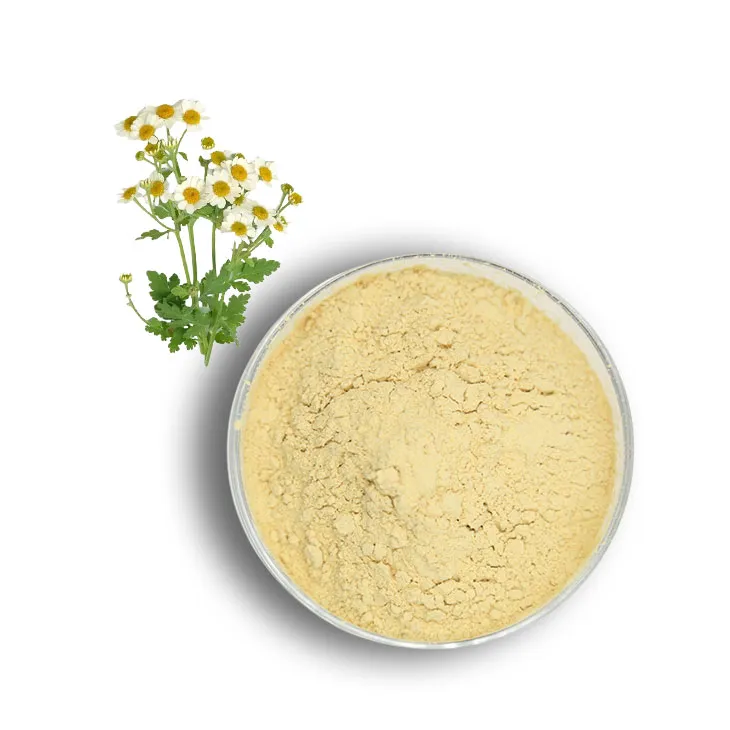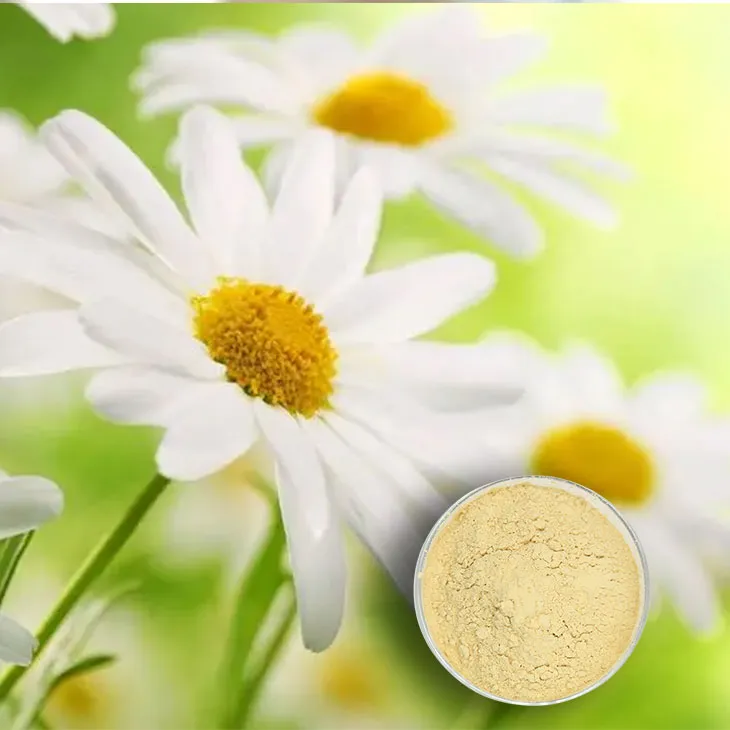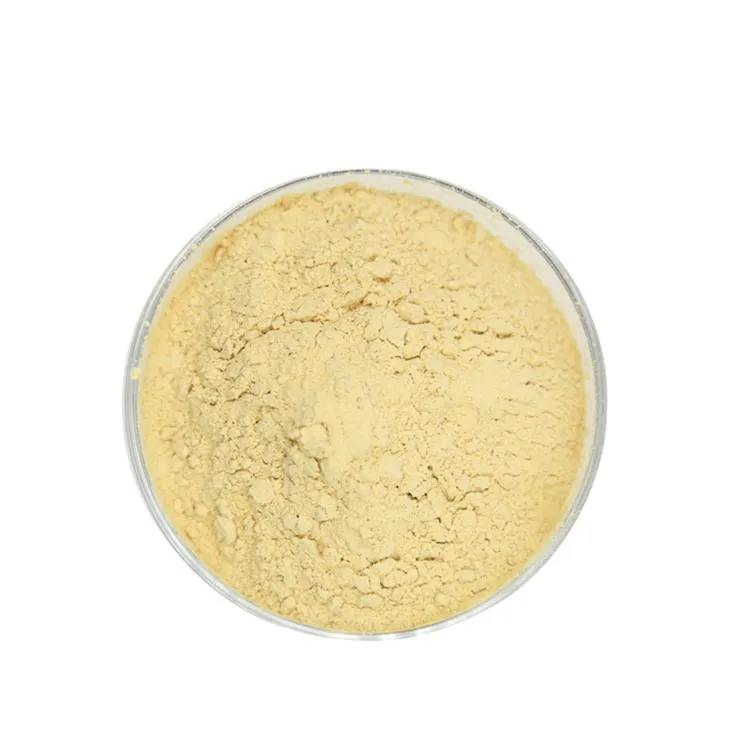- 0086-571-85302990
- sales@greenskybio.com
The Optimal Method for Extracting Feverfew Extract.
2024-11-28

1. Introduction
Feverfew (Tanacetum parthenium), also known as white chamomile, has been used for centuries in traditional medicine for various purposes, such as treating migraines, reducing inflammation, and relieving pain. The extraction of its active compounds is crucial for harnessing its potential benefits. This article will explore different extraction methods, taking into account environmental impact, equipment requirements, and product quality.

2. Common Extraction Methods
2.1 Solvent Extraction
2.1.1 Organic Solvents
- One of the most traditional methods is using organic solvents like ethanol or methanol. Ethanol is a popular choice due to its relatively low toxicity compared to other organic solvents.
-
Procedure:
- First, the feverfew plant material is dried and ground into a fine powder. This increases the surface area available for extraction.
- Then, the powdered material is soaked in ethanol in a suitable container. The ratio of plant material to solvent is an important factor. For example, a ratio of 1:5 (plant material : ethanol) is often used.
- The mixture is stirred continuously for a certain period, usually several hours to days. This allows the active compounds to dissolve into the solvent.
- After that, the mixture is filtered to separate the liquid extract from the solid plant residue.
- However, the use of organic solvents has some drawbacks. Environmental Impact: There are concerns about the disposal of solvent waste, which can be harmful to the environment if not properly managed. Product Quality: Some solvents may leave traces in the final extract, which might be undesirable for certain applications, especially in pharmaceutical or food - related products.
2.2 Supercritical Fluid Extraction (SFE)
2.2.1 Basics of SFE
- Supercritical fluid extraction uses a substance at its supercritical state, most commonly carbon dioxide (CO₂). At supercritical conditions, CO₂ has properties between those of a gas and a liquid, which makes it an excellent solvent for extracting various compounds.
-
Procedure:
- The feverfew plant material is prepared in a similar way as for solvent extraction, i.e., dried and ground.
- The supercritical CO₂ is passed through the plant material in an extraction vessel. The pressure and temperature are carefully controlled to maintain the supercritical state of CO₂. For example, typical conditions might be around 70 - 80 bar pressure and 35 - 40°C temperature.
- The active compounds are selectively extracted by the supercritical CO₂. Since different compounds have different solubilities in supercritical CO₂, the extraction can be optimized to target specific components.
- After extraction, the pressure is reduced, which causes the CO₂ to return to its gaseous state, leaving behind the extracted compounds.
- Environmental Impact: Supercritical CO₂ is considered a "green" solvent as it is non - toxic, non - flammable, and has a relatively low environmental impact. The CO₂ can be recycled, reducing waste. Equipment Requirements: However, SFE requires specialized and expensive equipment, including high - pressure pumps and extraction vessels. Product Quality: It can produce a high - quality extract with minimal solvent residue, which is beneficial for applications in the pharmaceutical and nutraceutical industries.
2.3 Hydro - distillation
2.3.1 Principle and Process
- Hydro - distillation is a method based on the principle that the active compounds in feverfew can be vaporized along with water vapor. The vapor is then condensed to obtain the extract.
-
Procedure:
- The feverfew plant material is placed in a distillation apparatus, usually along with water. The ratio of plant material to water can vary depending on the specific requirements.
- The mixture is heated, and as the water boils, the vapor carries the volatile compounds from the plant material.
- The vapor is then passed through a condenser, where it is cooled and converted back into a liquid. This liquid contains the extracted compounds along with water.
- The water and the extract are then separated, usually by using a separating funnel or other separation techniques.
- Environmental Impact: Hydro - distillation generally has a lower environmental impact compared to some organic solvent - based methods. However, it can be energy - intensive, especially if large - scale production is considered. Equipment Requirements: The equipment required for hydro - distillation is relatively simple and inexpensive compared to SFE, but it still requires a reliable heat source and proper distillation and condensation apparatus. Product Quality: The extract obtained by hydro - distillation may contain some water - soluble impurities, which may need further purification depending on the intended use.

3. Factors Affecting the Choice of Extraction Method
3.1 Intended Application
- If the Feverfew Extract is intended for pharmaceutical use, product quality in terms of purity and absence of harmful residues is of utmost importance. In such cases, supercritical fluid extraction may be the preferred method due to its ability to produce high - quality extracts with minimal solvent residue.
- For use in the cosmetic industry, where the extract may be used for its anti - inflammatory or skin - soothing properties, solvent extraction or hydro - distillation may be sufficient, depending on the cost - effectiveness and the desired characteristics of the final product.
- In the food and beverage industry, where the extract may be used as a flavoring or functional ingredient, the choice of extraction method needs to consider not only product quality but also regulatory requirements regarding the use of solvents and the presence of residues.
3.2 Cost Considerations
- Solvent extraction, especially when using relatively inexpensive solvents like ethanol, can be a cost - effective method for small - scale or pilot - scale production. However, the cost of solvent disposal needs to be factored in.
- Supercritical fluid extraction has high initial equipment costs, but in the long run, for high - value products where product quality is crucial, it may be more cost - effective due to the high - quality extracts it can produce and the potential for recycling the CO₂.
- Hydro - distillation has relatively low equipment costs, but it can be energy - consuming, which may increase the overall cost, especially for large - scale production.
3.3 Scale of Production
- For small - scale production, solvent extraction or hydro - distillation may be more practical due to their relatively simple equipment requirements and lower initial investment.
- As the scale of production increases, supercritical fluid extraction may become more viable, especially if the product demands a high - quality extract and the cost of equipment can be spread over a larger production volume.

4. Optimization of Extraction Conditions
4.1 Temperature
- In solvent extraction, increasing the temperature can generally increase the solubility of the active compounds in the solvent. However, too high a temperature may also cause degradation of some heat - sensitive compounds. For example, in ethanol extraction of feverfew, a temperature range of 40 - 60°C may be optimal.
- In supercritical fluid extraction, temperature affects the density and solubility of the supercritical fluid. Different active compounds may have different optimal extraction temperatures in supercritical CO₂. For instance, some flavonoids in feverfew may be best extracted at around 40°C.
- In hydro - distillation, temperature directly affects the rate of vaporization. Higher temperatures can lead to faster distillation, but may also cause over - heating and degradation of some compounds. A temperature around 100°C (the boiling point of water) is commonly used, but careful control is necessary.
4.2 Pressure
- Pressure is a crucial factor in supercritical fluid extraction. As mentioned earlier, maintaining the appropriate pressure (such as 70 - 80 bar for CO₂) is essential for keeping the fluid in its supercritical state and optimizing the extraction of different compounds.
- In hydro - distillation, pressure can also affect the boiling point of water and the vaporization of the active compounds. Although the impact is not as significant as in supercritical fluid extraction, proper control of pressure can still improve the extraction efficiency.
4.3 Extraction Time
- For solvent extraction, longer extraction times generally lead to higher yields of the active compounds. However, after a certain point, the increase in yield may become marginal, and extended extraction times may also increase the risk of solvent - related impurities. For example, in ethanol extraction, an extraction time of 24 - 48 hours may be sufficient for a good yield.
- In supercritical fluid extraction, the extraction time depends on factors such as the flow rate of the supercritical fluid, the nature of the plant material, and the solubility of the target compounds. Typically, extraction times can range from 1 - 6 hours.
- In hydro - distillation, the extraction time is related to the amount of plant material, the rate of heating, and the efficiency of condensation. Longer distillation times may be required for larger amounts of plant material, but again, over - distillation may lead to degradation of compounds.

5. Conclusion
There are several methods for extracting Feverfew Extract, each with its own advantages and disadvantages in terms of environmental impact, equipment requirements, and product quality. The choice of extraction method depends on various factors such as the intended application, cost considerations, and scale of production. Additionally, optimizing the extraction conditions such as temperature, pressure, and extraction time can improve the yield and quality of the extract. Overall, a comprehensive understanding of these factors is essential for obtaining the optimal Feverfew Extract for different applications.

FAQ:
Question 1: What are the main extraction methods for white chamomile extract?
There are several common extraction methods for white chamomile extract. One is solvent extraction, which involves using solvents like ethanol or methanol to dissolve the active compounds from the plant material. Another method is steam distillation, which is often used to obtain the essential oils present in white chamomile. Supercritical fluid extraction is also an option, using substances like carbon dioxide in a supercritical state to extract the desired components with high selectivity.
Question 2: How does solvent extraction affect product quality?
Solvent extraction can have both positive and negative impacts on product quality. On the positive side, it can effectively extract a wide range of compounds, resulting in a relatively complete extract. However, the choice of solvent is crucial. If the solvent is not properly removed, it may leave residues in the extract, which can be harmful and reduce the purity of the product. Also, some solvents may cause denaturation or degradation of certain sensitive compounds, affecting the overall quality of the white chamomile extract.
Question 3: What are the equipment requirements for steam distillation of white chamomile?
For steam distillation of white chamomile, the basic equipment includes a distillation flask, a condenser, a receiving flask, and a heat source. The distillation flask should be large enough to hold the white chamomile plant material and the water for steam generation. The condenser is essential for cooling the vapor and converting it back into liquid form. A proper heat source, such as an electric heater or a gas burner, is needed to provide the energy for the distillation process. Additionally, proper tubing and fittings are required to connect the different components of the apparatus.
Question 4: How can we minimize the environmental impact during the extraction of white chamomile extract?
To minimize the environmental impact, several steps can be taken. In solvent extraction, choosing green solvents such as ethanol, which is relatively more environmentally friendly compared to some toxic solvents, is a start. For any extraction method, proper waste management is crucial. This includes treating and disposing of any waste solvents or plant residues in an environmentally responsible way. In steam distillation, using energy - efficient heating methods can reduce energy consumption and associated environmental impacts. Also, if possible, sourcing white chamomile from sustainable cultivation practices can help reduce the overall environmental footprint of the extraction process.
Question 5: Which extraction method is most suitable for obtaining high - quality white chamomile extract?
The most suitable extraction method for obtaining high - quality white chamomile extract depends on various factors. Supercritical fluid extraction often results in a very pure and high - quality extract as it can be highly selective and operates under mild conditions that preserve the integrity of the active compounds. However, it requires more specialized equipment and is relatively more expensive. Steam distillation is excellent for obtaining the essential oils, which are important components of white chamomile extract. Solvent extraction can be a cost - effective method for obtaining a comprehensive extract, but care must be taken to ensure purity and quality. In general, a combination of methods may sometimes be the best approach to achieve the highest - quality white chamomile extract.
Related literature
- Optimization of White Chamomile Extract Extraction Techniques"
- "The Influence of Extraction Methods on the Quality of White Chamomile Extract"
- "Environmental Considerations in White Chamomile Extract Extraction"
- ▶ Hesperidin
- ▶ Citrus Bioflavonoids
- ▶ Plant Extract
- ▶ lycopene
- ▶ Diosmin
- ▶ Grape seed extract
- ▶ Sea buckthorn Juice Powder
- ▶ Fruit Juice Powder
- ▶ Hops Extract
- ▶ Artichoke Extract
- ▶ Mushroom extract
- ▶ Astaxanthin
- ▶ Green Tea Extract
- ▶ Curcumin
- ▶ Horse Chestnut Extract
- ▶ Other Product
- ▶ Boswellia Serrata Extract
- ▶ Resveratrol
- ▶ Marigold Extract
- ▶ Grape Leaf Extract
- ▶ New Product
- ▶ Aminolevulinic acid
- ▶ Cranberry Extract
- ▶ Red Yeast Rice
- ▶ Red Wine Extract
-
Bilberry Extract
2024-11-28
-
Red Date Extract
2024-11-28
-
Plantain extract
2024-11-28
-
Dan Shen Root Extract/Salvia Root Extract
2024-11-28
-
melatonin extract
2024-11-28
-
Grape Leaf Extract
2024-11-28
-
Sugarcane Extract
2024-11-28
-
Red Vine Extract
2024-11-28
-
Sophora Flavescens Root Extract
2024-11-28
-
Grape Seed Extract
2024-11-28





















